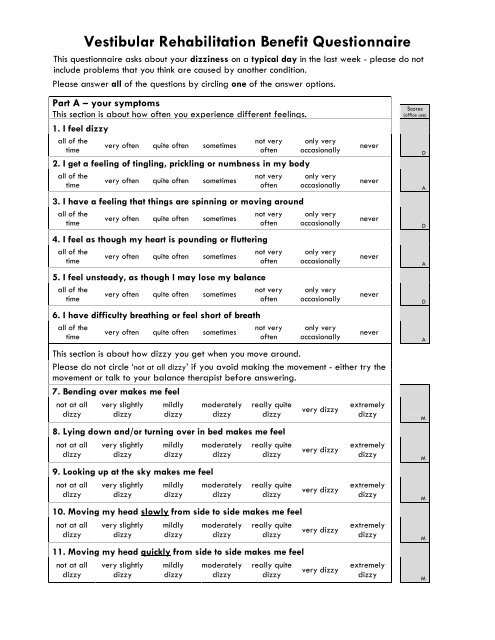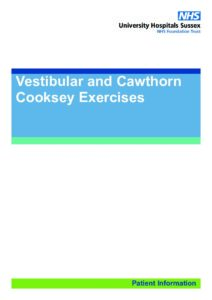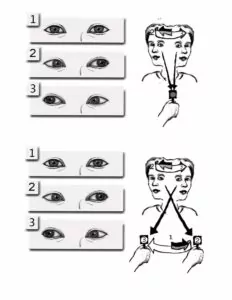vestibular exercises pdf nhs
At first slow then quick a up and down b from side to side c focus on finger moving from 3ft to 1ft away from face 2 Head movements. Please be aware that for some exercises it may take a while for you to get used to it.

Wrist Exercises Wrist Exercises Hand Therapy Exercises Hand Therapy
122019 AAHC VertigoVestibular Vestibular Rehabilitation Exercises Level 1 page 2.

. The brain interprets information gained from the vestibular or balance system. In section A the exercises should be done with eyes open. At first slow then quick.
Brandt-Daroff exercises These exercises are a method of treating Benign Paroxysmal Positional Vertigo BPPV. NHS Trust How to do the exercises 1. Exercise set 2 Sitting.
0845 120 2975 Web. Vestibular rehabilitation exercises A fact sheet for patients and carers Vestibular compensation Vestibular compensation is a process that allows the brain to regain balance control and minimise dizziness symptoms when there is damage to or an imbalance between the right and left vestibular organs balance organs in the inner ear. Head exercises Gaze stabilization Target must remain in focus not blurry and appear stationary while head is in motion Perform exercise with little head movement 45º to either side of.
To enable this to work fully you will need to be dedicated to doing exercises regularly through. L Exercises should be performed 3 times a day. 0161 716 3178 Comments and complaints.
The Brandt-Daroff exercises should be performed for two or three weeks and a suggested schedule is as follows Time exercise duration. Perform the standing exercises with no shoes on or with flat-heeled shoes. Do the exercises one two or three times a day.
Level 1 Eye movements head kept still a Look up then down. It helps to retrain the brains ability to adjust the balance problem and is known as compensation and adaption. Do not rush the exercises.
L All exercises should be performed slowly to begin with and gradually progress to faster movements. For example acute vestibular migraine or Ménières disease because the brain cannot adjust to the fluctuating nature of these disorders. This adds up to 42 sets in total.
Vestibular exercises merely stimulate the vestibular apparatus. Do not perform the exercises more strenuously or vigorously than you. Cawthorne-Cooksey Exercises SUPPORTING INSPIRING AND EDUCATING THOSE AFFECTED BY BALANCE AND DIZZINESS DISORDERS Updated June 2018.
Some evidence suggests that the exercises help to relocate the loose crystals that cause the dizziness in the first place. Exercises to improve standing. As they are designed to challenge your balance system you may feel some.
Exercises l Make sure that you are in a safe environment before you start any of the exercises to reduce the risk of injury. Vestibular rehabilitation wwwuhcwnhsuk - 2 - From this assessment the audiologist will develop an individualised treatment plan that will include exercises to be performed both in the department and at home which combine specific head and body movements with eye exercises. Start sitting upright on the edge of the bed.
Support and information to those affected by vestibular disorders. Around when you exercise. Eye and head movement exercises.
If an exercise does not cause. In approximately 30 percent of patients BPPV will recur within one year. Keeping head still move eyes left to right 3.
Extra Vestibular Rehabilitation Exercises Procedure Make sure you are seated safely before starting the exercises. Eye head and shoulder movements as above 2. Eye movements and head movements as above 2.
These exercises should be performed for two weeks three times per day or for three weeks twice per day. Your vestibular rehabilitation exercises are designed to make you experience mild. C Focus on fingers at arms length.
Be careful when you start to move after you have completed the exercises. Available from the NHS. Do one group of exercises at a time starting with the first set.
A bend backwards and forwards b turn from side to side B Sitting 1 and 2 - as above. Allow about 20 minutes for each session and allow time for a rest afterwards. They succeed in 95 of cases but more arduous than the Epley manoeuvre.
Eye and head movement exercises. Following a thorough examination a specialist Physiotherapist will develop a personalised home exercise programme for you. Later with eyes closed.
Lie down on your right side. Turn your head 45 degrees to the left or as far as is comfortable. How difficult should my exercises feel.
Repeat each exercise 3-4 times a day for. Brandt-Daroff exercises Brandt-Daroff exercises are a series of simple movements that can help stop the dizzy spells that people with BPPV experience. Exercises A In bed 1 Eye movements.
It is important to complete your exercises this often every day. Within the vestibular or balance system. Exercises for long-term balance problems.
The exercises that the audiologist recommends for you are listed over the page. Vestibular Rehabilitation is an exercise-based programme to encourage the nervous system to compensate for problems in the inner ear. You may find it helpful to complete your exercises at specific times each day.
The management plan may include. In all other sections exercises should be carried out five times with eyes open and five times with eyes shut. Use the table on page 12 to help you keep track of your exercises.
Shoulder shrugging and circling 3. The management plan may include. Exercise set 2 Sitting.
Please do all six movements 2-3 times each day. Cawthorne-Cooksey Vestibular Exercises Section A. Changing from sitting to standing position with eyes open and shut 3.
During vestibular rehabilitation therapy VRT home exercises are a vital part of treatment. Vestibular rehab exercises pdf nhs Saturday April 2 2022 Edit. Vestibular rehabilitation exercises This is a specific form of physiotherapy which may be suggested if your movements are very affected.
Treatment may also include increasing. Bending forward and picking up objects from the ground Exercise set 3 Standing. At home with an internal door.
When there is an injury or abnormality in any portion of this system the brain must be retrained or taught to interpret correctly the information it receives. Remain in this position for 30 seconds or until any dizziness has. In most persons complete relief from symptoms is obtained after 30 sets or about 10 days.
NHS Trust How to do the exercises 1. Vestibular rehabilitation home exercises Exercises performed at home are sometimes recommended. It is not clear why the exercises work.
Activities that promote Vestibular input Swings linear or rotation Sitting in a Rocking chair Gaming style floor chair Spinning chair Balance board Yoga especially inversion poses Hanging upside down this can be achieved at the park swinging from a tree branch. We recommend that you complete your exercises three times a day if possible. Remain in this position for 30 seconds or until you no longer feel dizzy.

Vestibular Neuronitis Vestibular Neuritis Conditioner Inner Ear

Pdf Effects Of Vestibular Training On Postural Control Of Healthy Adults

Vestibular Rehabilitation Benefit Questionnaire

Rehabilitation Exercises Exercise Images Rehabilitation

Vestibular Rehab Physio Vestibularp Twitter

Vestibular Rehabilitation Benefit Questionnaire

Vestibular Rehabilitation Benefit Questionnaire

Pdf Effects Of Vestibular Rehabilitation In The Elderly A Systematic Review

Vestibular Neuronitis Vestibular Neuritis Conditioner Inner Ear

Vestibular Rehabilitation Giddiness Exercises Youtube

Pdf Vestibular Rehabilitation In Europe A Survey Of Clinical And Research Practice

Wrist Exercises Mobilityexercises Wrist Exercises Hand Therapy Exercises Hand Therapy

Vestibular And Cawthorn Cooksey Exercises Brighton And Sussex University Hospitals Nhs Trust

Pdf Protocol For A Randomised Controlled Feasibility Study Of Psychologically Informed Vestibular Rehabilitation For People With Persistent Dizziness Invest Trial
